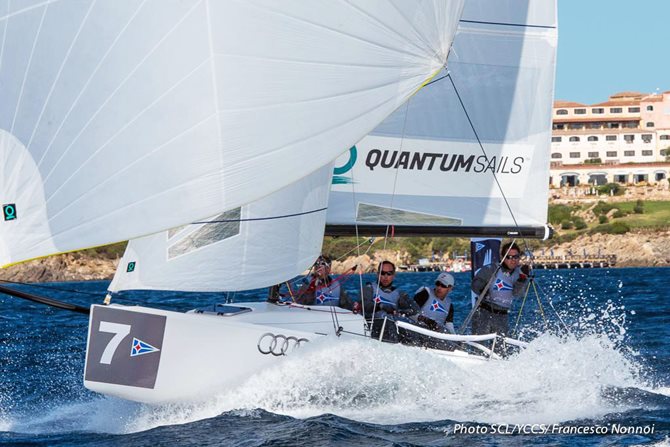The 2015 Sailing Champions League marked the inaugural regatta for the Yacht Club Costa Smeralda’s brand new fleet of J/70 boats. As the official provider of technical support and sails for the new fleet, Quantum played a key role in readying the new boats for their first race. Vittorio d’Albertas and Fernando Sallent talk about what they did to set up the new J/70s and what they recommend you do to get your own boat up to speed quickly.

The 2015 Sailing Championship League was held September 18-20th. Yacht Club Costa Smerelda hosted 30 teams representing Yacht Clubs from 14 different nations that qualified in their respective national leagues. Racing was held in the new fleet of J/70s and after three days of racing with a wide range of wind conditions, the Royal Norwegian Yacht Club was crowned the “Best Sailing Club of the Year.”
Vittorio d’Albertas, Fernando Sallent, and other Quantum experts were on site for support and service – both in preparation and throughout the event. The experts used Quantum’s Scott Nixon’s tuning guide in preparation for the event and setting up tensions for each day. Teams, unable to change their settings during the event, also used the tuning guide for boat handling tips and tricks. You can download the full guide here. After the success of the first event, we caught up with Vittorio and Fernando and put together their top advice for setting up a new boat.
Witness the Early Stages of Boat Preparation
The Quantum team was lucky enough to witness and be a part of the early stages of boat preparation at the Sailing Champions League. Best thing to do is to make sure to witness every stage of boat and mast preparation, so you know all the secrets of your own boat. Measuring spreaders, shrouds, spreader height and knowing all the fittings will help solve every problem of speed or setup you may find along the way. For example, during the early rigging process Vittorio and team noticed a few spreader heights were not accurate and were able to adjust accordingly prior to the event.
Check Keel & Rudder Alignment
Checking keel and rudder alignment, together with their profiles is a key factor to performance. Not every yard manages to be a 100% accurate, so it’s important to double check measurements yourself.
Center the Mast
Use tape measure and halyard to ensure the mast is centered. Without the mast being centered, it will be impossible to obtain the desired setup. The Quantum team found their base setting using caliper shrouds and headstay. This allowed them to be fast and accurate in preparation and guarantee the boats would be fast on the water.
Mark your Settings
Mark sheets, halyards, and other controls to make settings repeatable and more accurate. While marking settings sounds obvious, this can aid in tuning out on the water. Set a base mark and adjust accordingly for different conditions.
Don’t be Afraid to Change
Be aware of how the boat feels. If there is something wrong don’t be afraid to change just because you rely too much on the numbers. Find a good explanation if the change has gone in the right direction. Make sure to write all of your tuning path down, so you don’t make the same mistake twice and you can go back whenever needed.
Practice
For the Sailing Champions League, the teams were only allowed a couple of sailing hours the day before the event under SCL supervision. Teams who practiced at home before the event were much better prepared and performed better, while less prepared teams were unable to recover. Having a perfectly tuned boat may not be enough if your team’s boat handling and maneuvers are costing you speed. One of the incredible features of the event was the SAP Analytic Software. Each boat was fitted with GPS tracking units and incorporated with real time wind data. This gave teams the opportunity to see a completely accurate picture of each race and analyze key incidents.